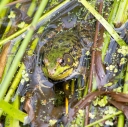Atlantic Coast Leopard Frog (Lithobates kauffeldi)
Description: The frogs' coloring ranges from mint-gray to light olive green, and brown spots distribute irregularly across their backs and legs. Dark snout lines run along their heads. They have large eyes and strong legs used for leaping. Coloring has been observed to change between day and night as well as with the seasons, with many individuals taking nocturnal darker tones and diurnal lighter hues.
Adult males have large vocal sacs on either side of the head which are used to produce a mating call. This call is a single and distinct "chuck" sound rather than the repeated "ak-ak-ak" of related species.
Habitat: L. kauffeldi tends to inhabit large wetland areas, such as marshes, wet meadows, or slow-flowing water. Its habitat usually includes clear, shallow water. The species lives in or around open, vegetated spaces as well, with such plants as cattails, reeds, or river shrubs.
Range: L. kauffeldi100 is found along the northeastern coast of the United States from central Connecticut to northeastern North Carolina. The north-south range is approximately 485 miles long, and the width is about 62 miles from the Atlantic shoreline inward. The range narrows as it progressed southward, mostly along the I-95 corridor. The species is thought to inhabit ten states, but the entirety of its distribution and range is not known.
Diet: Although tadpoles eat mostly plant matter, adult leopard frogs eat many insects that we do not like, such as mosquitoes and ticks.
Reproduction: The species breeds at a similar time of year as many other leopard frog species. The frogs commence migrations in February and March. As the air temperature rises in March and April, males begin consistent nocturnal choruses of mating calls, though both sustained diurnal and nocturnal choruses have been observed. They float in shallow water in groups of five or more and call to females. The advertisement call does not travel far, which may be a reason for dense groups. Breeding continues through spring and early summer, peaking in a 2-3 week period in late March and early April in New York. Eggs are laid in clusters.
Status: Relatively small range in northeastern United States; recently recognized as a distinct species; fairly large number of subpopulations and locations; locally common; apparently extirpated or reduced in area of occupancy and abundance in significant portions of historical range; now probably relatively stable or slowly declining; threats include habitat alteration and possibly invasive plant species and other factors. Pennsylvania and New York classified it is Critically Imperiled while North Carolina has it classified as Vulnerable.
»» Kingdom: Animalia - Animals
»» Phylum: Chordata - Chordates
»» Subphylum: Vertebrata - Vertebrates
»» Class: Amphibia - Amphibians
»» Order: Anura - Frogs & Toads
»» Family: Ranidae - True Frogs
»» Genus: Lithobates
»» Species: Lithobates kauffeldi - Atlantic Coast Leopard Frog
»» Subspecies: None
This article uses material from the Wikipedia article "Atlantic Coast Leopard Frog", which is released under the Creative Commons Attribution-Share-Alike License 3.0. Content may have been omitted from the original, but no content has been changed or extended.
|







